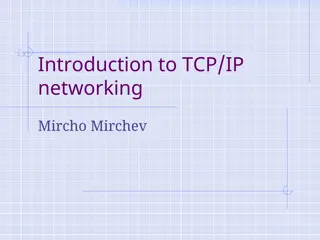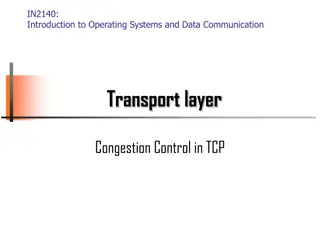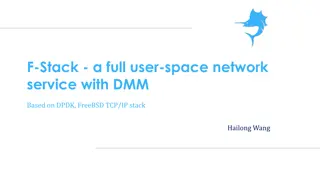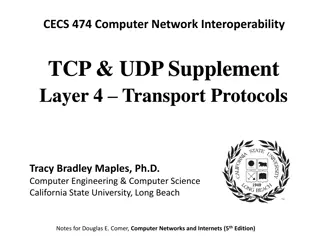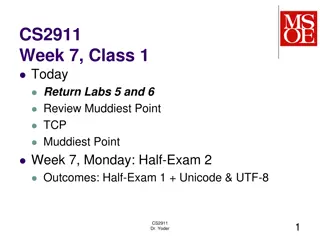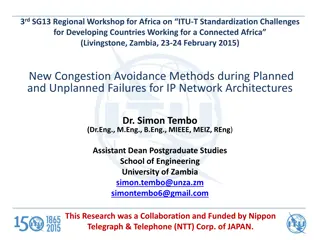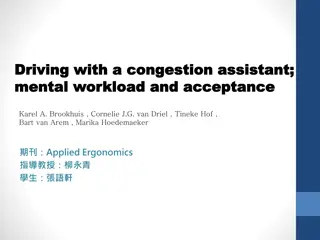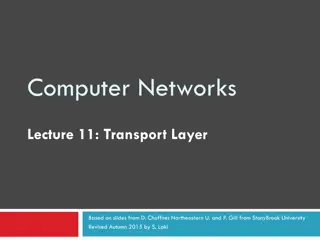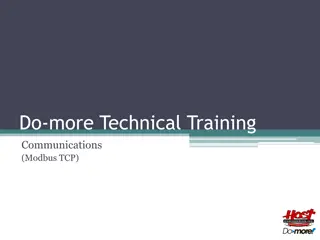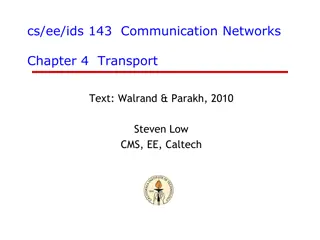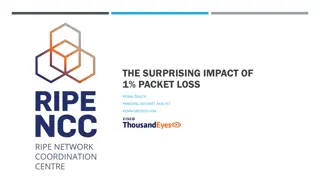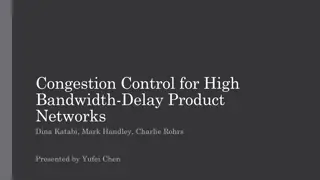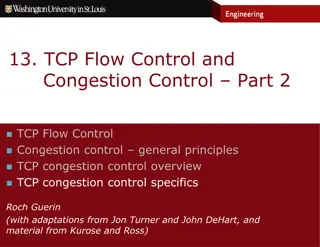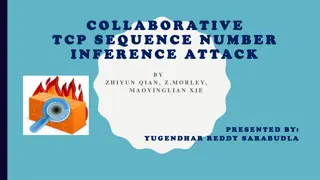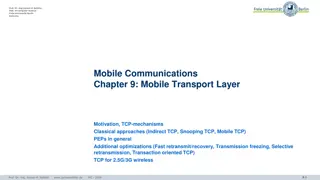TCP Congestion Control Basics
This content covers the basics of congestion control in TCP, including aspects such as reliable data transfer tools, checksum usage, and receiver feedback. It's based on material from the book "Computer Networking: A Top Down Approach, 6th edition" by J.F. Kurose and K.W. Ross, and a lecture by Bill Nace in the course 14-740: Fundamentals of Computer Networks. Understanding these concepts is crucial for optimizing network performance and ensuring efficient data transmission.
Download Presentation

Please find below an Image/Link to download the presentation.
The content on the website is provided AS IS for your information and personal use only. It may not be sold, licensed, or shared on other websites without obtaining consent from the author. Download presentation by click this link. If you encounter any issues during the download, it is possible that the publisher has removed the file from their server.
E N D
Presentation Transcript
TCP Congestion Control 14-740: Fundamentals of Computer Networks Credit: Bill Nace, 14-740, Fall 2017 Material from Computer Networking: A Top Down Approach, 6thedition. J.F. Kurose and K.W. Ross
Last Lecture Reliable Data Transfer Tools Checksum Receiver Feedback Retransmission Timer Sequence Number Window / Pipelining 14-740: Fall 2017 2
traceroute Connection-oriented Transport: TCP Segment Structure Connection Management Reliable Data Transfer 14-740: Fall 2017 3
TCP Overview Point-to-point One sender, one receiver Reliable Segments delivered in-order without loss In-order byte stream No message / record boundaries Pipelined Sliding-window type control algorithm 14-740: Fall 2017 4
TCP Overview Full duplex data bi-directional data flow in the same connection Connection-oriented handshaking (exchange of control messages) initializes sender & receiver state before data exchange 14-740: Fall 2017 5
Both sides have buffers Lots of Producer-Consumer coordination problems to overcome
Transmission Control Flow Control Sender will not overwhelm receiver Congestion Control Various algorithms employed to limit sending of segments Don t want to overwhelm the network 14-740: Fall 2017 7
traceroute Connection-oriented Transport: TCP Segment Structure Connection Management Reliable Data Transfer 14-740: Fall 2017 8
Format Port numbers like UDP 16-bit, some are "well-known" not same as UDP 14-740: Fall 2017 9
Format Seq# and Ack# counted by bytes of data, not segments Seq: number of the first byte in this segment Ack: number of the NEXT expected byte Acks are cumulative 14-740: Fall 2017 10
Flag Field Header Length (4 bits) # words (32-bit) Usually 5 (20 bytes) Can be longer with options 14-740: Fall 2017 11
Flag Field ACK: Segment acknowledges receipt of another segment (i.e. ack seq# is good) Setup and teardown signals SYN: Synchronize seq# FIN: No more data from sender RST: Reset connection Rarely used PSH: Push the data to app-layer immediately URG: Urgent data, indicated by Urgent Data Pointer 14-740: Fall 2017 12
Format Receive window #bytes receiver is willing to accept For flow-control 14-740: Fall 2017 13
Format Checksum Same as UDP Urgent data pointer Offset in data field Options Time stamps Window scaling factors Negotiating MSS 14-740: Fall 2017 14
Format Application Data Size limited by MSS MSS=Maximum Segment Size Despite name, MSS is most app data that can be carried MTU (Max Trans Unit) of lower level generally drives MSS App data + TCP header + IP overhead must fit in MTU MSS is often 1460, 536 or 512 bytes 14-740: Fall 2017 15
Question Huge file of L bytes, MSS of 1200 bytes, TCP sequence number field of 4 bytes What is the maximum value of L such that TCP sequence numbers are not reused? Kind of a trick question TCP sequence number is based on number of bytes, not segments MSS is irrelevant Sequence number field is 32-bits, but all sequence number arithmetic is modulo 232 so a theoretical file of L = bytes is possible 14-740: Fall 2017 17
traceroute Connection-oriented Transport: TCP Segment Structure Connection Management Reliable Data Transfer 14-740: Fall 2017 18
TCP Connection Management Why connection establishment? TCP sender, receiver setup state before exchanging data segments Initialize TCP variables: seq#s buffers, flow control info (RcvWindow) Why connection teardown? Free up state 14-740: Fall 2017 19
Three-way Handshake Step 1: client sends TCP SYN segment to server specifies initial seq# holds no data Step 2: server responds with SYNACK segment server allocates buffers specifies initial seq# Step 3: Client replies with ACK may contain data
Question TCP specification requires each side of a connection to select an initial starting sequence number at random1. Why? Let s say TCP does not exchange initial sequence numbers, and just use 0 as the starting point. What can happen? An earlier incarnation of the same connection can interfere with a later one 1Not exactly, but it's complicated. Let's pretend it is random. 14-740: Fall 2017 22
Go Away, Dude If a host receives a TCP SYN segment to a closed port, it responds with a RST segment UDP sends a special ICMP packet in this situation 14-740: Fall 2017 23
Closing a Connection Step 1: Client sends TCP FIN segment to server Step 2: Server receives FIN, responds with ACK Closes connection Sends FIN Recall: Connection is bi- directional, needs to be shut down from each side
Closing a Connection Step 3: client receives FIN, replies with ACK Client enters timed wait Will respond to FIN with ACK 240 seconds (2x max time a segment can exist in internet) Step 4: server receives ACK, closes connection
Question Why does client enter timed wait state before closed, even after receiving FIN from server?
Answer What happens if ACK from the client is lost, and the client does not wait? Client may open the same connection again (same pair of port #s) Receives FIN from earlier incarnation of connection Immediately initiate closing of the later incarnation
traceroute Connection-oriented Transport: TCP Segment Structure Connection Management Reliable Data Transfer 14-740: Fall 2017 28
TCP RDT TCP creates RDT service on top of IP s unreliable service Pipelined segments Cumulative acks Retransmission timer Retransmissions are triggered by: timeout events duplicate acks Initially, we consider simplified TCP sender: ignore duplicate acks ignore flow control, congestion control assume RTT is estimated somehow
TCP Seq# and ACKs Sequence numbers: byte stream number of first byte in segment s data ACKs: seq # of next byte expected from other side cumulative ACK acknowledges bytes up to the first missing byte in the stream piggybacked with data, if possible
TCP Sender Events Data received from app: Create segment seq# is byte-stream number of first data byte in segment Send, if allowed by congestion & flow-control start timer if not already running (think of timer as for oldest unacked segment) expiration interval: TimeOutInterval Timeout: retransmit segment that caused timeout restart timer ACK received: If acknowledges previously unACKed segments update what is known to be ACKed start timer if there are outstanding segments
ACK Generation Event at receiver Receiver Action Arrival of in-order segment with expected seq#. All data up to seq# already ACKed Delayed ACK. Wait up to 500ms for next segment. If no next segment, send ACK Arrival of in-order segment with expected seq#. One other segment has ACK pending Immediately send single cumulative ACK for both in- order segments Arrival of out-of-order segment higher than expected seq#. Gap detected Immediately send duplicate ACK, indicating seq# of next expected byte Immediately send ACK, provided that segment starts at lower end of gap Arrival of segment that partially or completely fills gap 14-740: Fall 2017 38
Fast Retransmit Time-out period often relatively long: Long delay before resending lost segment Detect lost segments via duplicate ACKs Sender often sends many segments back- to-back If segment is lost, there will likely be many duplicate ACKs If sender receives 3 duplicate ACKs, it supposes that segment after ACKed data was lost: Fast retransmit: resend segment before timer expires
Scenario Fast Retransmission Sender doesn t have to wait for a timeout to notice probable loss of seq=100 segment Sort of a NACK
Why 3? Why 3 duplicate ACKs? Why not do fast retransmit after the first duplicate ACK for a segment is received? If n+1 and n+2 (or n+3) are just reordered, then waiting for 2 duplicate ACKs will not retrigger retransmission Voodoo constant
Lesson Objectives Now, you should be able to: describe the requirements and features of TCP describe the segment format of TCP calculate MSS from the relationship of MTU, Network and Transport header sizes 14-740: Fall 2017 42
You should be able to: describe the operations behind establishing and tearing-down a TCP connection describe the operation of sender and receiver in reliably transferring data across the TCP connection. This description should include events occurring at the sender (including fast retransmission optimizations) and receiver, as well as scenarios whereby error conditions are overcome
Flow and Congestion Control (Hosts) 14-740: Fundamentals of Computer Networks Material from Computer Networking: A Top Down Approach, 6thedition. J.F. Kurose and K.W. Ross
traceroute Flow Control Principles of Congestion Control TCP Congestion Control 14-740: Fall 2017 45
Flow Control In RDT lecture, we discovered windows for managing pipelined transfer But, didn't discuss windows (much) in TCP lecture TCP has 2 windows Flow Control Window Congestion Control Window Sender limited by smallest window Flow Control != Congestion Control 14-740: Fall 2017 46
Both sides have buffers Lots of Producer-Consumer coordination problems to overcome
Flow Control Receive side of TCP connection has a receive buffer of size RcvBuffer Application process may be slow at reading from the buffer 14-740: Fall 2017 48
Flow Control (2) Flow Control: Sender won t overflow the receiver s buffer by transmitting too much, too fast Speed-matching service: matching the send rate to the receiving app s drain rate 14-740: Fall 2017 49
Mechanism Spare room in buffer = RcvWindow Yes, this assumes receiver discards out-of-order segments. Easy enough to program around simplification = RcvBuffer - [LastByteRcvd - LastByteRead] 14-740: Fall 2017 50
Mechanism (2) Receiver advertises spare room by including value of RcvWindow in ACK segment Gives sender permission to send this much Sender limits unACKed data to RcvWindow bytes 14-740: Fall 2017 51
traceroute Flow Control Principles of Congestion Control TCP Congestion Control 14-740: Fall 2017 52
Router View Router buffer absorbs temporary bursts when input rate > output rate When buffer is full, router cannot accept more packets and must drop them 14-740: Fall 2017 53
Costs of Congestion 14-740: Fall 2017 54
Costs of Congestion Packets can experience large queuing delays Even if not dropped (adv topic: Bufferbloat) Packets can be dropped due to buffer overflow Sender must perform retransmission of lost segments Retransmission might not be necessary but was triggered by premature timeout Wasted network resources 14-740: Fall 2017 55
Congestion Too many sources sending too much data too fast for network to handle Different than flow control! As network load increases, some router has many packets queued in its buffer, resulting in: Long delays as packets wait for processing Lost packets as buffer space overflows, cannot handle any more incoming packets! 14-740: Fall 2017 56
Congestion Control Goal: large throughput and small delay To increase throughput, send more packets More packets increases queue length at routers -- delay increases Large throughput != small delay 14-740: Fall 2017 58
Congestion Control (2) Apply some control theory Region 1: Low throughput Region 2: High delay Throughput increases slowly Delay increases quickly Region 3: Collapse Throughput 0, Delay At what load would we like to operate? 14-740: Fall 2017 60

 undefined
undefined






